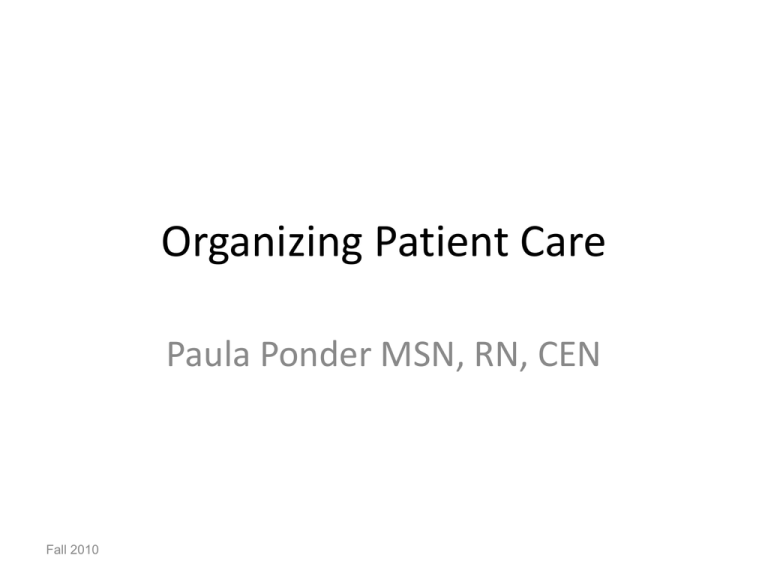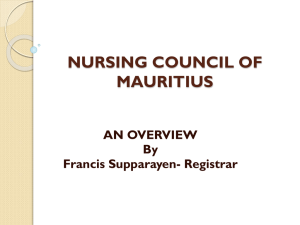Organizing Patient Care
advertisement

Organizing Patient Care Paula Ponder MSN, RN, CEN Fall 2010 Learning Objectives • differentiate among various types of patient care delivery systems • discuss the relationship between managed care and case management • list the essential components of total patient care, team nursing, primary nursing, and case management • discuss how work redesign may affect social relationships on a unit • explain what effect staff mix has on work design and the patient care organization Fall 2010 • What is our focus…… • Why are we here……. • ….patients now more than ever need reassurance that they are indeed the focus of the healthcare team - Joan Shinkus Clark Fall 2010 Traditional Modes of Care Delivery • • • • • Total Patient Care Functional Nursing Team and Modular Nursing Primary Nursing Case Management • Care delivery modalities (modes) affect autonomy and job satisfaction. • Direct pt care functions are actually caring for pt. • Indirect pt care functions are like being able to self schedule, charting • All of these depend on what mode of care you are using, and on how or when you get to use them Fall 2010 Total Patient Care • Total patient care - nurses assume total responsibility for meeting all needs of assigned patients during their time on duty – For the entire shift nurse takes care of pt. Initially occurred in ICU units – Form of primary nursing – Advantages – intensity of focus on the pt thru-out that shift – Disadvantages – lack of communication and lack of continuity over time. Just meeting daily needs, not trying to make a plan and get them out Fall 2010 Functional Method • Functional nursing - work assignment by functions or tasks, such as passing medicine, doing dressing changes, giving baths, or taking vital signs • Assignment by function. Everybody has a task. Norm in the US hospitals from late 1800’s til the end of WWII. There was a shortage of nurses at the time, so we put people in who can do things, like a team who went thru and checked dressings, a team that took vital signs, etc. • Advantage – no role confusion. You knew what you were doing. This method is efficient and cheap. • Disadvantage – client couldn’t identify who their caretaker was, because there were so many caretakers. Fall 2010 Team Nursing • Team nursing - a team of RNs, licensed practical nurses (LPNs), and aides under the supervision of one nurse, called the team leader – Group can be 10-20 pt’s to 4-5 nurses. Over each group of teams is a charge nurse. Has evolved into modular nursing (more of a spacial thing). Clients are grouped by a floor plan, happens a lot in ED’s. We’re in pod A, which has 10 beds, it’s intermediate care, and we’re in pod A all day. RN assigns work on team members expertise. Who’s good at what, what can this person do, and where do you want to put them. You’re accountable for delegating things to people who are trained to do them. Fall 2010 Primary Nursing • Primary nursing is an approach in which a nurse has responsibility and accountability for the continuous guidance of specific clients from hospital admission through discharge – She would be assigned a group of pt’s (kind of like a nurse manager) and she’s responsible for them their entire hospital stay. Ponder thinks it sounds very challenging. – Hallmark to this is that you have autonomy/accountability 24 hours a day. You make treatment decisions and what not Fall 2010 Case Management • Case management in acute care hospital nursing has been defined as a system of client care delivery that focuses on the achievement of client outcomes within effective and appropriate time frames and resources – Also focus on containing health care costs first for the pt, then for the facility. – Practicing case manamgement can also be- I get this pt and I check him and I consult all these specialists (like neurologist and social workers) about his condition and checking his discharge stuff and looking over everything. Sometimes hospitals don’t have specific case managers, but every nurse is expected to be their pt’s case Fall 2010 manager… CASE MANAGEMENT SERVICE AREAS Category Service Setting Acute Orthopedics, cardiovascular, critical care, high-risk perinatal, oncology, emergency department Subacute Skilled nursing centers, rehabilitation units Ambulatory Physician's office, clinics Long-term care Nursing homes, group homes, assisted-living facilities Insurance companies Health maintenance organizations (HMOs), preferred provider organizations (PPOs), workers' compensation, Medicaid, Medicare Community Nurse-managed centers, home health agencies, urgent care centers, schools, rural settings Fall 2010 Disease Management • Common high-cost, high-resource utilization diseases • Population-based health care – Covered lives • Continuous health improvement • A population with a costly disease, people who are on outpt dialysis. Focus is on the population. We want to provide optimal, cost effective care. By doing this we can actually do a lot of prevention (hopefully). Going to diabetic clinic and teaching them so we can hopefully prevent them from reaching the need for outpt dialysis. Differentiated Nursing Practice • Education Model (Type 1) – Based on type of education – They’ve been trying to do this for a long time • Competency Model (Type 2) – Based on individual skill level • Benner’s Novice to Expert (goes along with competency model) – Novice – Advanced beginner – Competent nurse – Proficient nurse – Expert Fall 2010 Differentiated Nursing Practice Cont. • To match the pt’s needs with nursing competence, and have the most efficient use of nursing resources. • Education based thing really irritates Ponder. She thinks RN’s who pass boards are RN’s who pass boards. • Competency she agrees with. Placing SICU nursing in SICU, not taking a newborn nurse and putting them in SICU. That’s not fair to the SICU pt. • Match the pt’s needs with the abilities of the nurse The Future • Nursing shortages and health care reform have had a strong impact on the creation of new and evolving types of patient care delivery models. – We’re seeing pt focus teams. By that she means the teams have nurses, PT, OT, Dietary, any body else that you can possibly thing of. Everyone gets an input, and you have all the teams working together. The challenges • • • • • Fall 2010 Cost containment Demand for quality outcomes Information age Patient population Multigenerational workforce The Optimum Mode of Care • Carefully constructed • Not based solely on economics Fall 2010 Integrating Leadership Roles • No one best mode • Accomplishment of unit goals • Seeking solutions not finding fault – Working together • • • • Facilitates innovative thinking Ensures adequate resources Reduce resistance Remember, change is inevitable Fall 2010 Summary • Nursing leaders and managers have the responsibility to facilitate the design of care delivery models • Nurses deliver and coordinate patient care • The challenges for patient care in the future are massive • The work environment of the nurse is dramatically different from any other time • Discover innovative ways to organize and deliver care Fall 2010








